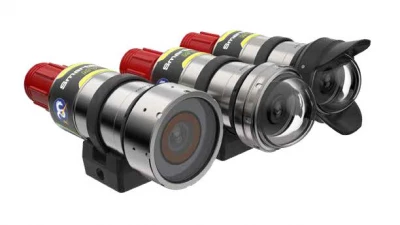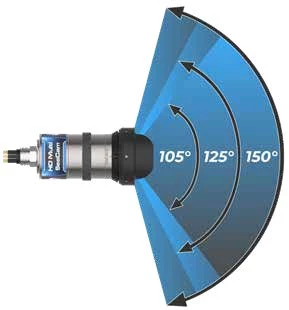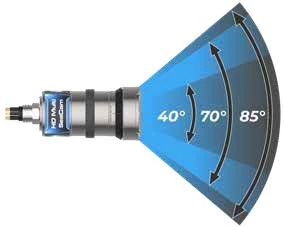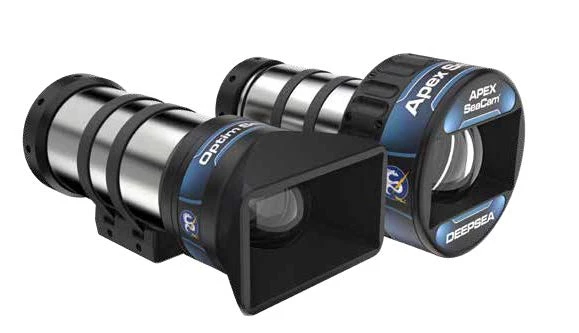New Range of Cameras
Machine Vision Cameras

DeepSea has formally launched its innovative SmartSight MV1 imaging system. Built around best-in-class technology, the SmartSight MV1 is capable of producing up to 5MP images at 21 frames per second, uncompressed, over Ethernet. Unlike other camera imagery, however, it is not meant to be looked at by humans, but machines. It has been tailored to the growing needs of autonomy, machine learning, artificial intelligence (AI), and other potential machine vision applications.
The first in a new category of products from DeepSea, it is designed to push the adoption and ease of implementation of machine vision systems into next-generation autonomous platforms. “Fully compliant with the GigE Vision 2.0 standard,” said General Manager – Oceanographic Products, Aaron Steiner, “imaging system architects will now have an off-the-shelf solution to add computer vision components to their designs, freeing them up to focus on the value-add autonomy, object recognition, navigation, and inspection technology that sets them apart.
“We see it being used in industrial automation so customers can get imagery into their applications, such as for object tracking navigation feedback or object recognition. We’ve been developing this in collaboration with a few partners both in the science and oceanographic space in the energy sector. “In these applications, it is desirable to work with the raw data as much as possible for high-end processing” said Steiner. “IP video stream loses a lot of the detail. We developed the SmartSight MV1 to help our customers get through that initial hump of the data burden before they can really add the value of automation tasks.”
The camera is certified to 6000m, but DeepSea say that they can work in full ocean if needed. “A typical application might be for the camera to be attached to the outside of seabed lander or underwater vehicle in the path of sea creatures,” said Steiner. “Interpretational software can scan the image and, using machine learning methods, identify species and flag specimens that do not appear in a database. “We offer various camera and lens configurations, providing anything from a 0.4MP (more suited to lower light conditions) to a higher definition 5MP version,” said Steiner. “In addition to a video, it can also be used as a type of stills camera, linked to strobes to provide images while conserving power. This power conservation allows us to extend the mission time.


Multi SeaCam
DeepSea recently expanded the “Multi” part of its HD Multi SeaCam product family with the introduction of four new lens options, providing both wider and more focused fields of view. When initially launched, the HDMSC-4000 series cameras were available with either a 105deg or 72deg horizontal field of view. DeepSea has now expanded this to include options for an ultra-wide 150deg and low distortion 125deg wide angle in the dome port configuration, along with an 85deg and a narrow 40deg horizontal option in the flat port housing. The new 2.0mm (150 deg HFoV) all-glass lens produces the widest field of view in its class with sharp corner-to-corner imaging and linear distortion that maintains consistent angular resolution across the field of view.
Second in the line-up is the new 2.3mm (125deg horizontal field of view) lens option, which balances a wide field of view with optimised light control to minimize ghosting and lateral colour shift. The dome port optics minimize distortion and bring out exceptional detail across the field of view. The same 2.3mm lens is also available in the flat port housing configuration where it achieves an unprecedented 85deg horizontal field of view in water with near zero distortion. This pushes the very limit of what can be achieved behind a flat port before critical angle refraction begins to block light from entering the lens.
Finally, a narrower 6mm lens option in the flat port housing brings out the finer details by bringing the subject closer. At 40deg, the horizontal field of view in water is significantly narrower than the other options, which makes it excel at inspection tasks and gauge monitoring where the camera can be positioned farther away from the subject. All four new lens options are available now in coax SDI, exclusive FleXlink SDI, and IP versions of the HD Multi SeaCam product family.
Analogue Anachronism?

In these days where there seems no alternative to digital IP cameras, it is understandable that many have assumed analogue cameras as an anachronism. It is perhaps surprising, then, that DeepSea has added analogue interfaces to its IP Apex and IP Optim SeaCam 4K cameras.
So what benefits do analogue systems still provide?
“We actually sell more analogue than digital cameras, although it’s just beginning to tip towards digital,” said Steiner. “If anybody is designing an ROV today, they probably won’t look at analogue cameras, but there is still a lot of legacy infrastructure out there. “In situations where video requires being transmitted over a longer cable, the digital options are pretty limiting. You don’t really want to put in a fibre where you can put in a coaxial cable. “In many cases, analogue cameras can be smaller, typically because the technology is more mature and can be miniaturised more easily than the digital IP cameras or SDI type cameras.
“Users say that it is still hard to beat some of the sensitivity of high resolution analogue cameras,” continued Steiner. “Of course you don’t get the same level of detail –our highest resolution analogue sensor is about 700 TV lines, but for the right application that’s not necessarily a problem. It is generally very simple to integrate, and a lot of systems and vehicles still have analogue architecture built in. “Analogue systems have a more square frame as opposed to the wide frame video common to HD video images. These are often more appealing to pilots who can get a better understanding of the view they are seeing.
“Analogue signals can travel much further than digital signals, possibly thousands of feet, although to do this, there are trade-offs, particularly in colour information. “Because it’s still an analogue signal, there is often a loss of some of the high frequency content and this has colour information.” Providing the IP Optim and IP Apex Cameras with an analogue interface is designed to improve the flexibility of these 4K camera assets.
“Our 4K cameras have about a 70deg field of view compared to the 170 deg perspective from our Super Wide-I SeaCam. Switching over to the analogue feed provides a different perspective, but all over the same interface. From a practical viewpoint, the main camera streams 4K images over the Internet. It has room for more than one bulkhead interface, and this makes it simple to add the secondary analogue camera.
“The camera interface allows a system designer to incorporate an auxiliary video source that can be streamed via h.264 or h.265 over Ethernet in addition to the internal 4K video feed,” said Steiner. “This means that the camera can be added without the need for additional multiplexer channels, making it possible to include wide-angle context cameras, tooling cameras, or low-light video on the same IP video interface that streams live 4K video. Switching between the video sources is done through the web-based user interface in just a few clicks.
In addition to the auxiliary analogue camera input, a virtual RS-485 COM port has been added, which can be connected to external smart devices such as the LED SeaLite LSL-2000 family of luminaires. The demonstration unit included a total of four smart lights connected to the IP Apex in addition to an analogue camera. Using the IP Apex or IP Optim SeaCam as a communication hub allows for a constellation of lights or other networkable RS-485 devices to be operated from a common interface in real time.
